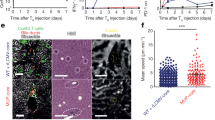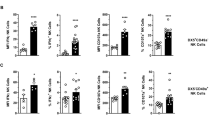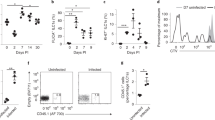Abstract
Persistent hepatitis B virus (HBV) infection results in chronic liver diseases that may progress to chronic hepatitis, liver cirrhosis, and subsequent hepatocellular carcinoma. Previous studies demonstrated that adaptive immunity, in particular CD8 T cells, is critical in HBV elimination. Recent studies have revealed a distinct tissue-localized T cell lineage, tissue-resident memory (TRM) cells, that is crucial for protective immunity in peripheral tissues. In this study, we showed that treatment with an anti-asialo GM1 (ASGM1) antibody (Ab), which depletes NK cells, led to impairment of HBV clearance in a mouse animal model. Unexpectedly, the ability to clear HBV was not significantly impaired in NFIL3 KO mice, which are deficient in NK cells, implying that other non-NK ASGM1-positive immune cells mediate HBV clearance. We isolated intrahepatic ASGM1-positive cells from NFIL3 KO mice and analyzed the immune phenotype of these cells. Our results demonstrated a distinct population of CD44+ LFA-1hi CD8 T cells that were the major intrahepatic ASGM1-positive immune cells in NFIL3 KO mice. Importantly, transcriptome analysis revealed that these ASGM1-positive CD8 T cells had distinct gene profiles and shared a similar core gene signature with TRM cells. In addition to both transcriptional and phenotypic liver residency characteristics, ASGM1-positive CD8 T cells were able to home to and be retained in the liver after adoptive transfer. Taken together, our study results indicate that these ASGM1-positive liver-resident CD8 T cells are the major effector immune cells mediating anti-HBV immunity.
This is a preview of subscription content, access via your institution
Access options
Subscribe to this journal
Receive 12 digital issues and online access to articles
$119.00 per year
only $9.92 per issue
Buy this article
- Purchase on Springer Link
- Instant access to full article PDF
Prices may be subject to local taxes which are calculated during checkout







Similar content being viewed by others
References
Tzeng, H. T. et al. Tumor necrosis factor-alpha induced by hepatitis B virus core mediating the immune response for hepatitis B viral clearance in mice model. PLoS ONE 9, e103008 (2014).
Yang, P. L. et al. Immune effectors required for hepatitis B virus clearance. Proc. Natl Acad. Sci. USA 107, 798–802 (2010).
Yeo, W. et al. Hepatitis B virus reactivation in lymphoma patients with prior resolved hepatitis B undergoing anticancer therapy with or without rituximab. J. Clin. Oncol. 27, 605–611 (2009).
Wieland, S., Thimme, R., Purcell, R. H. & Chisari, F. V. Genomic analysis of the host response to hepatitis B virus infection. Proc. Natl Acad. Sci. USA 101, 6669–6674 (2004).
Kashii, Y., Giorda, R., Herberman, R. B., Whiteside, T. L. & Vujanovic, N. L. Constitutive expression and role of the TNF family ligands in apoptotic killing of tumor cells by human NK cells. J. Immunol. 163, 5358–5366 (1999).
Kasai, M., Iwamori, M., Nagai, Y., Okumura, K. & Tada, T. A glycolipid on the surface of mouse natural killer cells. Eur. J. Immunol. 10, 175–180 (1980).
Kasai, M. et al. In vivo effect of anti-asialo GM1 antibody on natural killer activity. Nature 291, 334–335 (1981).
Young, W. W. Jr., Hakomori, S. I., Durdik, J. M. & Henney, C. S. Identification of ganglio-N-tetraosylceramide as a new cell surface marker for murine natural killer (NK) cells. J. Immunol. 124, 199–201 (1980).
Zheng, M., Sun, R., Wei, H. & Tian, Z. N. K. Cells help induce anti-hepatitis B virus CD8+ T cell immunity in mice. J. Immunol. 196, 4122–4131 (2016).
Mackay, L. K. et al. Long-lived epithelial immunity by tissue-resident memory T (TRM) cells in the absence of persisting local antigen presentation. Proc. Natl Acad. Sci. USA 109, 7037–7042 (2012).
Fernandez-Ruiz, D. et al. Liver-resident memory CD8(+) T cells form a front-line defense against malaria liver-stage infection. Immunity 45, 889–902 (2016).
Bergsbaken, T. & Bevan, M. J. Proinflammatory microenvironments within the intestine regulate the differentiation of tissue-resident CD8(+) T cells responding to infection. Nat. Immunol. 16, 406–414 (2015).
Sheridan, B. S. & Lefrancois, L. Regional and mucosal memory T cells. Nat. Immunol. 12, 485–491 (2011).
McNamara, H. A. et al. Up-regulation of LFA-1 allows liver-resident memory T cells to patrol and remain in the hepatic sinusoids. Sci. Immunol. 2, eaaj1996 (2017).
Steinert, E. M. et al. Quantifying memory CD8 T cells reveals regionalization of immunosurveillance. Cell 161, 737–749 (2015).
Budd, R. C., Cerottini, J. C. & MacDonald, H. R. Phenotypic identification of memory cytolytic T lymphocytes in a subset of Lyt-2+ cells. J. Immunol. 138, 1009–1013 (1987).
Richter, M. V. & Topham, D. J. The alpha1beta1 integrin and TNF receptor II protect airway CD8+ effector T cells from apoptosis during influenza infection. J. Immunol. 179, 5054–5063 (2007).
Mackay, L. K. et al. Cutting edge: CD69 interference with sphingosine-1-phosphate receptor function regulates peripheral T cell retention. J. Immunol. 194, 2059–2063 (2015).
Stark, R. et al. TRM maintenance is regulated by tissue damage via P2RX7. Sci. Immunol. 3, eaau1022 (2018).
Rissiek, B. et al. In vivo blockade of murine ARTC2.2 during cell preparation preserves the vitality and function of liver tissue-resident memory T cells. Front Immunol. 9, 1580 (2018).
Kamizono, S. et al. Nfil3/E4bp4 is required for the development and maturation of NK cells in vivo. J. Exp. Med. 206, 2977–2986 (2009).
Seillet, C. et al. Nfil3 is required for the development of all innate lymphoid cell subsets. J. Exp. Med. 211, 1733–1740 (2014).
Thimme, R. et al. CD8(+) T cells mediate viral clearance and disease pathogenesis during acute hepatitis B virus infection. J. Virol. 77, 68–76 (2003).
Tzeng, H. T. et al. PD-1 blockage reverses immune dysfunction and hepatitis B viral persistence in a mouse animal model. PloS ONE 7, e39179 (2012).
Mackay, L. K. et al. Hobit and Blimp1 instruct a universal transcriptional program of tissue residency in lymphocytes. Science 352, 459–463 (2016).
Keating, R. et al. Virus-specific CD8+ T cells in the liver: armed and ready to kill. J. Immunol. 178, 2737–2745 (2007).
Beura, L. K. et al. T cells in nonlymphoid tissues give rise to lymph-node-resident memory T cells. Immunity 48, 327–338 e325 (2018).
Victorino, F. et al. Tissue-Resident NK Cells Mediate Ischemic Kidney Injury and Are Not Depleted by Anti-Asialo-GM1 Antibody. J. Immunol. 195, 4973–4985 (2015).
Nishikado, H., Mukai, K., Kawano, Y., Minegishi, Y. & Karasuyama, H. NK cell-depleting anti-asialo GM1 antibody exhibits a lethal off-target effect on basophils in vivo. J. Immunol. 186, 5766–5771 (2011).
Kosaka, A. et al. AsialoGM1+CD8+ central memory-type T cells in unimmunized mice as novel immunomodulator of IFN-gamma-dependent type 1 immunity. Int. Immunol. 19, 249–256 (2007).
Slifka, M. K., Pagarigan, R. R. & Whitton, J. L. NK markers are expressed on a high percentage of virus-specific CD8+ and CD4+ T cells. J. Immunol. 164, 2009–2015 (2000).
Trambley, J. et al. Asialo GM1(+) CD8(+) T cells play a critical role in costimulation blockade-resistant allograft rejection. J. Clin. Invest. 104, 1715–1722 (1999).
Pallett, L. J. et al. IL-2(high) tissue-resident T cells in the human liver: sentinels for hepatotropic infection. J. Exp. Med. 214, 1567–1580 (2017).
Tse, S. W., Radtke, A. J., Espinosa, D. A., Cockburn, I. A. & Zavala, F. The chemokine receptor CXCR6 is required for the maintenance of liver memory CD8(+) T cells specific for infectious pathogens. J. Infect. Dis. 210, 1508–1516 (2014).
Mackay, L. K. et al. The developmental pathway for CD103(+)CD8+ tissue-resident memory T cells of skin. Nat. Immunol. 14, 1294–1301 (2013).
Acknowledgements
This work was supported by grants from the Ministry of Science and Technology (MOST 105-2320-B-038-065, MOST 106-2320-B-038-0193, MOST 107-2321-B-002-003, and MOST 108-2320-B-002-036-MY3).
Author information
Authors and Affiliations
Corresponding author
Ethics declarations
Competing interests
The authors declare no competing interests.
Supplementary information
Rights and permissions
About this article
Cite this article
Sung, CC., Horng, JH., Siao, SH. et al. Asialo GM1-positive liver-resident CD8 T cells that express CD44 and LFA-1 are essential for immune clearance of hepatitis B virus. Cell Mol Immunol 18, 1772–1782 (2021). https://doi.org/10.1038/s41423-020-0376-0
Received:
Accepted:
Published:
Issue Date:
DOI: https://doi.org/10.1038/s41423-020-0376-0
Keywords
This article is cited by
-
The role of CD56bright NK cells in neurodegenerative disorders
Journal of Neuroinflammation (2024)
-
Combined IL6 and CCR2 blockade potentiates antitumor activity of NK cells in HPV-negative head and neck cancer
Journal of Experimental & Clinical Cancer Research (2024)



